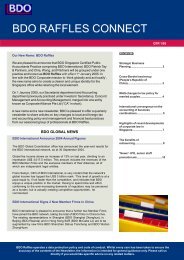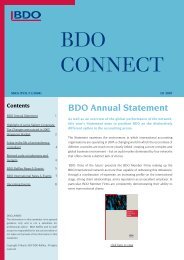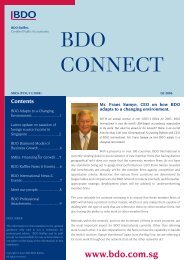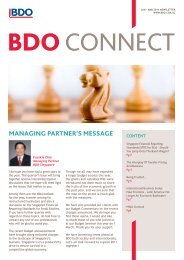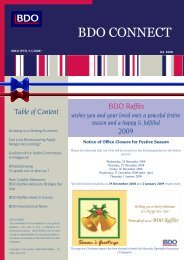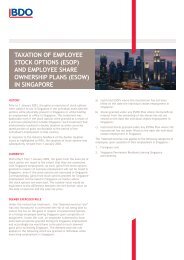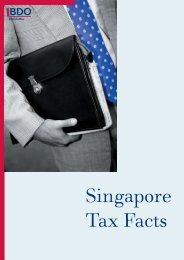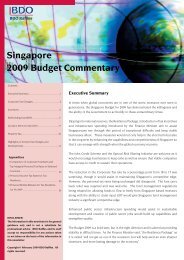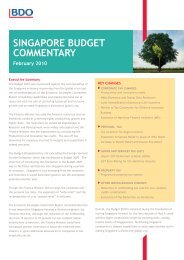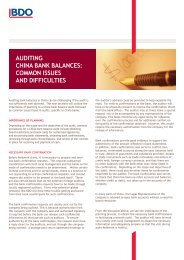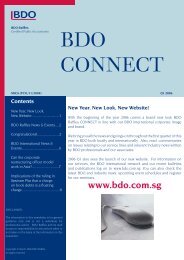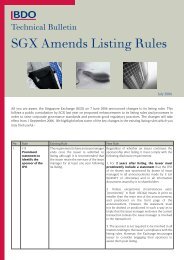Illustrative Financial Statements 2011 - bdo singapore
Illustrative Financial Statements 2011 - bdo singapore
Illustrative Financial Statements 2011 - bdo singapore
Create successful ePaper yourself
Turn your PDF publications into a flip-book with our unique Google optimized e-Paper software.
ABC SINGAPORE LIMITED AND ITS SUBSIDIARIES<br />
NOTES TO THE FINANCIAL STATEMENTS<br />
FOR THE FINANCIAL YEAR ENDED 31 DECEMBER <strong>2011</strong> (Continued)<br />
FRS 1: 112, 117<br />
2. Summary of significant accounting policies (Continued)<br />
2.12 Investment property (Continued)<br />
Commentary<br />
FRS 40: 75(c)<br />
FRS 1: 113<br />
FRS 40: 6<br />
FRS 40: 75(b)<br />
FRS 40: 30, 34<br />
(i) When judgement is required to determine the portions of investment property,<br />
owner-occupied property and property held for sale in the ordinary course of business,<br />
the entity shall disclose the criteria used to distinguish them and the judgements<br />
involved.<br />
(ii) A property interest that is held by a lessee under an operating lease may be classified<br />
and accounted for as an investment property, if and only if, the property would<br />
otherwise meet the definition of an investment property and the lessee uses the fair<br />
value model to account for the asset recognised. Once this classification is selected for<br />
the property held under the operating lease, all properties classified as investment<br />
property shall be accounted for using the fair value model. The entity shall disclose in<br />
what circumstances that the property interests held under operating leases are<br />
classified and accounted for as investment property.<br />
(iii) The entity can choose to apply the fair value model or the cost model to its investment<br />
property with the exception where the entity, as a lessee, classifies a property interest<br />
held by it under an operating lease as investment property.<br />
Then where the entity chooses to apply the cost model to its investment property, the<br />
following accounting policy may be adopted:<br />
FRS 40: 56<br />
FRS 40: 79(a), (b)<br />
FRS 40: 79(e)<br />
Investment property, which is property held to earn rentals and/or for capital<br />
appreciation is initially recognised at cost and subsequently carried at cost less<br />
accumulated depreciation and impairment losses. Depreciation is charged, using the<br />
straight-line method, so as to write off the cost over their estimated useful lives of<br />
[ ] years. The residual values, useful lives and depreciation method of investment<br />
properties are reviewed and adjusted as appropriate, at the end of each financial year.<br />
The effects of any revision are included in profit or loss when the changes arise.<br />
(iv) Under the cost model, the fair value of investment property shall be disclosed at the end<br />
of each financial year. In exceptional cases where the entity cannot determine the fair<br />
value of investment property reliably, it shall disclose:<br />
(a) A description of the investment property;<br />
(b) An explanation of why fair value cannot be determined reliably; and<br />
(c) If possible, the range of estimates within fair value is highly likely to lie.<br />
2.13 Intangible assets<br />
Goodwill<br />
FRS 103: 51<br />
FRS 103: 54<br />
FRS 36: 80<br />
FRS 36: 90<br />
FRS 36: 124<br />
Goodwill arising on the acquisition of a subsidiary or a jointly controlled entity represents the<br />
excess of the cost of acquisition over the Group’s interest in the net fair value of the identifiable<br />
assets, liabilities and contingent liabilities of the subsidiary or jointly controlled entity<br />
recognised at the date of acquisition. Goodwill is initially recognised as an asset at cost and is<br />
subsequently measured at cost less any accumulated impairment losses.<br />
For the purpose of impairment testing, goodwill is allocated to each of the Group’s<br />
cash-generating units expected to benefit from the synergies of the combination.<br />
Cash-generating units to which goodwill has been allocated are tested for impairment annually,<br />
or more frequently when there is an indication that the unit may be impaired. If the recoverable<br />
amount of the cash-generating unit is less than the carrying amount of the unit, the impairment<br />
loss is allocated first to reduce the carrying amount of any goodwill allocated to the unit and<br />
then to the other assets of the unit pro-rata on the basis of the carrying amount of each asset in<br />
the unit. An impairment loss recognised for goodwill is not reversed in a subsequent period.<br />
40 | P a g e



